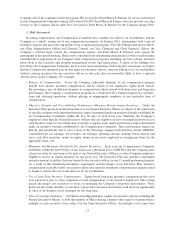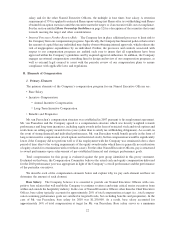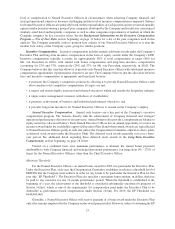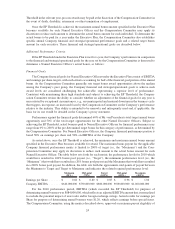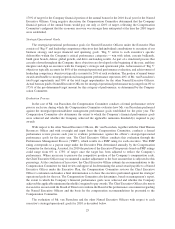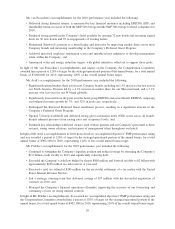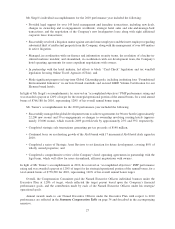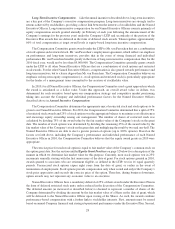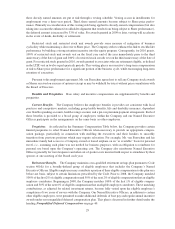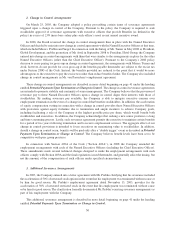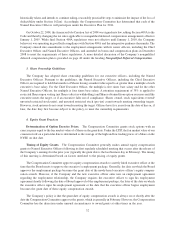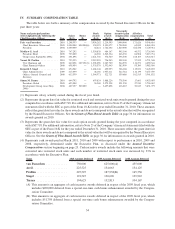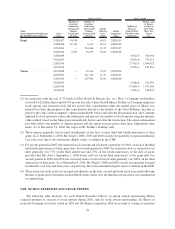Starwood 2010 Annual Report Download - page 42
Download and view the complete annual report
Please find page 42 of the 2010 Starwood annual report below. You can navigate through the pages in the report by either clicking on the pages listed below, or by using the keyword search tool below to find specific information within the annual report.2. Change in Control Arrangements
On March 25, 2005, the Company adopted a policy proscribing certain terms of severance agreements
triggered upon a change in control of the Company. Pursuant to the policy, the Company is required to seek
stockholder approval of severance agreements with executive officers that provide Benefits (as defined in the
policy) in excess of 2.99 times base salary plus such officer’s most recent annual incentive award.
In 2006, the Board reviewed the change in control arrangements then in place with the Named Executive
Officers and decided to enter into new change in control agreements with the Named Executive Officers at that time,
which included Messrs. Prabhu and Siegel. In connection with the hiring of Mr. Turner in May 2008 as President,
Global Development, and the promotion of Mr. Avril in September 2008 to President, Hotel Group, the Company
entered into change in control arrangements with them that were similar to the arrangements in place for the other
Named Executive Officers (other than the Chief Executive Officer). Pursuant to the Company’s 2008 policy
decision to cease paying tax gross-ups in change in control agreements, the arrangements with Messrs. Turner and
Avril, however, do not provide for a tax gross-up if the benefits payable thereunder are subject to the excise tax
under Section 280G of the Code. Instead, the benefits provided are reduced to the point that it would be more
advantageous to the executive to pay the excise tax rather than reduce benefits further. The Company also included
change in control arrangements in Mr. van Paasschen’s employment agreement.
These change in control arrangements are described in more detail beginning on page 41 under the heading
entitled Potential Payments Upon Termination or Change in Control. The change in control severance agreements
are intended to promote stability and continuity of senior management. The Company believes that the provision of
severance pay to these Named Executive Officers upon a change in control aligns their interests with those of
stockholders. By making severance pay available, the Company is able to mitigate executive concern over
employment termination in the event of a change in control that benefits stockholders. In addition, the acceleration
of equity compensation vesting in connection with a change in control provides these Named Executive Officers
with protection against equity forfeiture due to termination and ample incentive to achieve Company goals,
including facilitating a sale of the Company at the highest possible price per share, which would benefit both
stockholders and executives. In addition, the Company acknowledges that seeking a new senior position is a long
and time-consuming process. Lastly, each severance agreement permits the executive to maintain certain benefits
for a period of two years following termination and to receive outplacement services. The aggregate effect of our
change in control provisions is intended to focus executives on maximizing value to stockholders. In addition,
should a change in control occur, benefits will be paid only after a “double trigger” event as described in Potential
Payments Upon Termination or Change in Control. The Company believes benefit levels have been set to be
competitive with peer group practices.
In connection with Section 409A of the Code (“Section 409A”), in 2008 the Company amended the
employment arrangements with each of the Named Executive Officers (including the Chief Executive Officer).
These amendments made several technical changes designed to make the employment arrangements with such
officers comply with Section 409A and the final regulations issued thereunder, and generally affect the timing, but
not the amount, of the compensation of such officers under specified circumstances.
3. Additional Severance Arrangements
In 2007, the Company entered into a letter agreement with Mr. Prabhu clarifying that his severance included
the acceleration of 50% of unvested stock options in the event that his employment was terminated without cause or
by him for good reason. Mr. Prabhu’s employment agreement dated November 13, 2003, provides for the
acceleration of 50% of unvested restricted stock in the event that his employment was terminated without cause
or by him for good reason. The clarification formally documented Mr. Prabhu’s existing severance arrangements as
part of his employment with the Company.
This additional severance arrangement is described in more detail beginning on page 41 under the heading
entitled Potential Payments Upon Termination or Change in Control.
30



